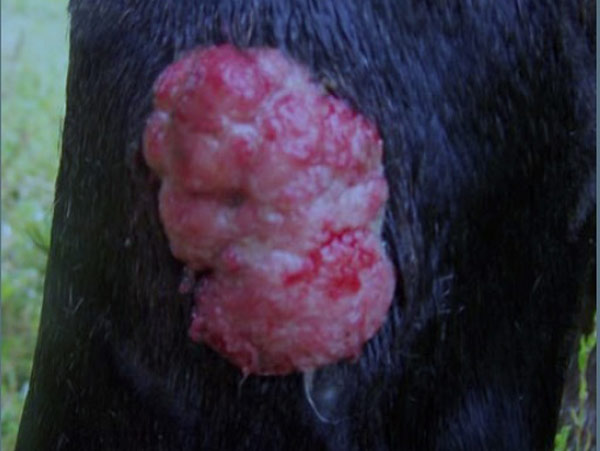
Exuberant granulation tissue (EGT), commonly known as proud flesh, is a frustrating complication of wound healing in horses. It can lead to extensive scarring and in serious cases, be detrimental to a horse’s career. Granulation tissue is red, moist, soft and bumpy. It bleeds easily when rubbed or scraped. It is considered exuberant when it becomes unorganized and extends beyond the margins of a wound. EGT most often develops in horses on wounds of the lower limb that are healing by second intention or those wounds that can’t or shouldn’t be sutured closed. EGT may develop due to chronic inflammation or lack of oxygen to the wound. Preventing EGT is easier than treating it.
The horse tends to have a weak acute inflammatory response in comparison to other mammals. This can delay wound healing and promote the formation of EGT. Boney fragments, foreign bodies and normal motion can also cause chronic inflammation in a wound. Many agents marketed to control granulation tissue actually cause more inflammation and/or damage the new skin cells. Surgical intervention, thorough cleaning, appropriate stabilization, and avoiding most topical agents will help decrease wound inflammation and the likelihood of EGT formation.
Bandaging can promote the formation of EGT by creating a low oxygen, high moisture environment. Bandages can also lead to chronic inflammation through direct wound irritation. Low oxygen levels in a wound have been shown to promote the proliferation of fibroblasts, a principal cell type of granulation tissue. Bandages have been found to lead to slower wound closure and a greater likelihood of excessive granulation tissue. If possible, application of bandages should be avoided on wounds healing by second intention. If a bandage is needed (i.e., to prevent further trauma or wound contamination), it should be applied to the wound only until a good granulation tissue bed has formed. Wounds should then be managed without a bandage. If bandaging is needed long term, various topical treatments can be applied to decrease the amount of exuberant granulation tissue. Examples of these topical treatments include corticosteroids and silicone.
If EGT has begun to form, it needs to be trimmed back until it does not rise over the wound edges. There are no nerves in this tissue so the horse does not usually object as long as healthy skin is not “trimmed.” However, granulation tissue is very vascular so bleeding is often significant and a temporary bandage may be needed for the first few hours. Trimming EGT does not seem to slow total healing time as long as the wound is otherwise healthy.
Topical corticosteroids can be applied to the wound to reduce the chronic inflammatory response and prevent the formation of EGT. One to two applications may be all that is needed. Prolonged use of corticosteroids should be avoided as the drug can interfere with the overall healing process. Silicone containing wound dressings can significantly decrease the likelihood of the formation of EGT and improve tissue quality. Silicone blocks certain inflammatory mediators and decreases tissue overgrowth. Silicone bandages can be used long term with fewer side effects than corticosteroids.
A 2010 study used unfocused extracorporeal shockwave therapy (ESWT) to treat limb wounds. ESWT did not accelerate the healing of wounds, but the wounds treated with ESWT did have less EGT. The results of this study suggested that ESWT can aid in the prevention of the formation of exuberant granulation tissue, but further research in this area is needed.
There are many different options for the prevention and treatment of EGT. Prevention currently centers on bandage management. More research needs to be done in order to understand the full potential of newer preventative modalities such as ESWT. Treatment should be limited to those methods and agents shown safe for new skin cells or you may be controlling the EGT, but also slowing wound healing.
Sign up for the University of Minnesota horse newsletter by visiting their website.
This article was written by Claire Kamrath, DVM, past University of Minnesota veterinary student.


